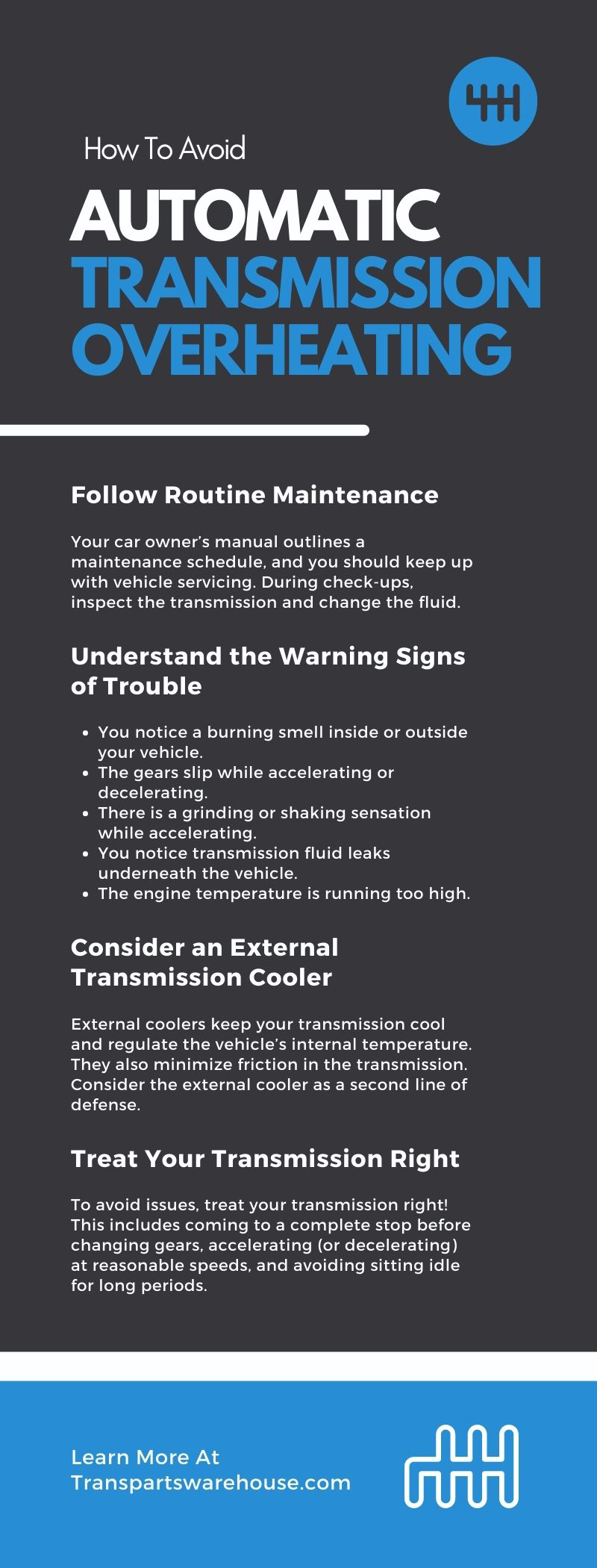
Transmission overheating occurs when your vehicle can’t regulate the system’s temperature. This leads to internal problems that require professional help. Luckily, there are ways to avoid automatic transmission overheating. Check out this helpful guide for beneficial information!
Why Do Transmissions Overheat?
While driving, it’s normal for your automatic transmission to become hot because it’s moving power from the engine to your wheels. To prevent overheating, your vehicle has a built-in automatic transmission cooler that reduces its temperature. The unit keeps the transmission fluid cool, which helps vehicle performance.
The transmission will overheat when the cooler can’t control the transmission’s temperature. This indicates an underlying problem that’s affecting the automatic transmission or engine. Typically, friction between internal parts causes the transmission to overheat. And there are different reasons why this may occur.
Why Are Overheated Transmissions Bad?
With the inability to keep the transmission and engine cool, you risk internal damage to your vehicle. You’ll often have to repair the transmission, and repairs range from $800 to $1,500. In severe cases, an automatic transmission replacement is necessary. This can cost $1,800 to $3,400 (depending on your vehicle’s age and model).
The expensive repair and replacement costs can burn a hole in any vehicle owner’s pocket. Unfortunately, a new transmission isn’t the only thing to worry about. An overheated system triggers engine problems. An engine replacement costs $3,000 to $5,000.
Basically, an overheated system creates a snowball effect of car problems. Understandably, no vehicle owner wants to spend thousands of dollars repairing their vehicle.
Heat: The Silent Killer
Excessive heat is the silent killer for automatic transmissions. In fact, many people don’t notice overheating until something breaks or the vehicle malfunctions. It’s crucial to incorporate transmission checks during your vehicle’s maintenance routine. Checking transmission fluid levels and taking note of its color and scent helps you determine the transmission’s condition.
Color and Scent Check
Understand the health of your automatic transmission by assessing the transmission fluid. Fresh fluid is bright red. Darker shades of red (i.e., brick red or maroon) are normal too. These shades indicate that the fluid was in your vehicle longer.
Brown and black fluid with a burnt smell indicates a problem! The transmission fluid is old or contaminated. Bad fluid overheats transmissions, and you’ll notice the burning smell.
Ways To Prevent Transmission Overheating
Of course, no one wants an overheated transmission. It affects vehicle performance and may lead to irreversible damage. Fortunately, following good practices can keep your unit cool and running smoothly. Check out these ways to avoid automatic transmission overheating:
Follow Routine Maintenance
One of the best ways to care for your transmission is to follow routine maintenance. Your car owner’s manual outlines a maintenance schedule, and you should keep up with vehicle servicing. During check-ups, inspect the transmission and change the fluid.
Professionals recommend changing the fluid every 30,000 to 60,000 miles. But if you live in hot climates or haul heavy loads, change the fluid more often. It’s also best to check fluid levels every few weeks to ensure they don’t get too low.
Pay attention to your transmission. Problems can develop over time, and it’s essential to stay on top of routine check-ups. If an issue occurs, you can solve the dilemma before it becomes a major problem.
Understand the Warning Signs of Trouble
As mentioned, heat is a silent killer for automatic transmissions. Many people don’t recognize issues until the vehicle malfunctions. However, there are some warning signs to watch out for. If you experience the following problems, it’s time to service your vehicle:
- You notice a burning smell inside or outside your vehicle. This means can mean the transmission fluid is burning or contaminated.
- The gears slip while accelerating or decelerating. Additionally, your vehicle doesn’t respond quickly.
- There is a grinding or shaking sensation while accelerating.
- You notice transmission fluid leaks underneath the vehicle.
- The engine temperature is running too high.
Consider an External Transmission Cooler
Consider an external transmission cooler if you frequently haul heavy loads like tools, wood, or other vehicles. Any vehicle that consistently moves heavy loads is at risk of overheating because of the extra stress. Essentially, the vehicle works double-time to handle the extra weight.
Fortunately, external coolers keep your transmission cool and regulate the vehicle’s internal temperature. They also minimize friction in the transmission. Consider the external cooler as a second line of defense. The heavy loads and increased stress won’t overheat the transmission with the help of the extra cooler!
You can install the device on your own or get assistance from a professional mechanic.
Treat Your Transmission Right
Your car’s transmission is delicate, and responsible driving prevents system troubles. Things like shifting gears or accelerating too fast put wear and tear on the transmission. This leads to overheating and shortens the system’s lifespan.
To avoid issues, treat your transmission right! This includes coming to a complete stop before changing gears, accelerating (or decelerating) at reasonable speeds, and avoiding sitting idle for long periods. You don’t want to do anything that puts unnecessary wear and tear on the system.
What To Do if Your Transmission Overheats
In the perfect scenario, your automatic transmission won’t overheat. Unfortunately, vehicle problems happen, and you may need to deal with overheated systems. If this happens, don’t panic! Instead, follow these steps:
- When you notice overheating, stop driving and let the transmission cool down.
- Take note of the vehicle’s condition during this time—for example, weird noises or smells coming from your car.
- After the system cools, restart the vehicle and drive to the nearest mechanic.
- An overheated transmission can lead to vehicle failure. While driving, avoid shifting gears too fast or putting excessive force on brake pads.
- When you arrive at the mechanic, let the professionals assess your transmission and pinpoint the cause of overheating.
Act Fast
The key to dealing with an overheated transmission is to act fast. The longer you wait to service the vehicle, the more problems can occur. One day, your gears may slip, and the next day you notice a shaking sensation. Don’t ignore the tell-tale signs of a problem!
The last thing you want is system failure because your vehicle won’t move with a failed system. That’s every car owner’s worst nightmare. Stay on the safe side, and always acknowledge car issues. After all, a minor repair is better than replacing the entire transmission.
When in doubt, visit a professional to check your vehicle and diagnose transmission problems.
Transparts Warehouse cares about your vehicle’s health. That’s why we offer premium transmission parts for sale. From torque converters to transmission coolers, we have it all. With affordable prices and excellent customer service, we’re here to help you. Browse our product categories today!


